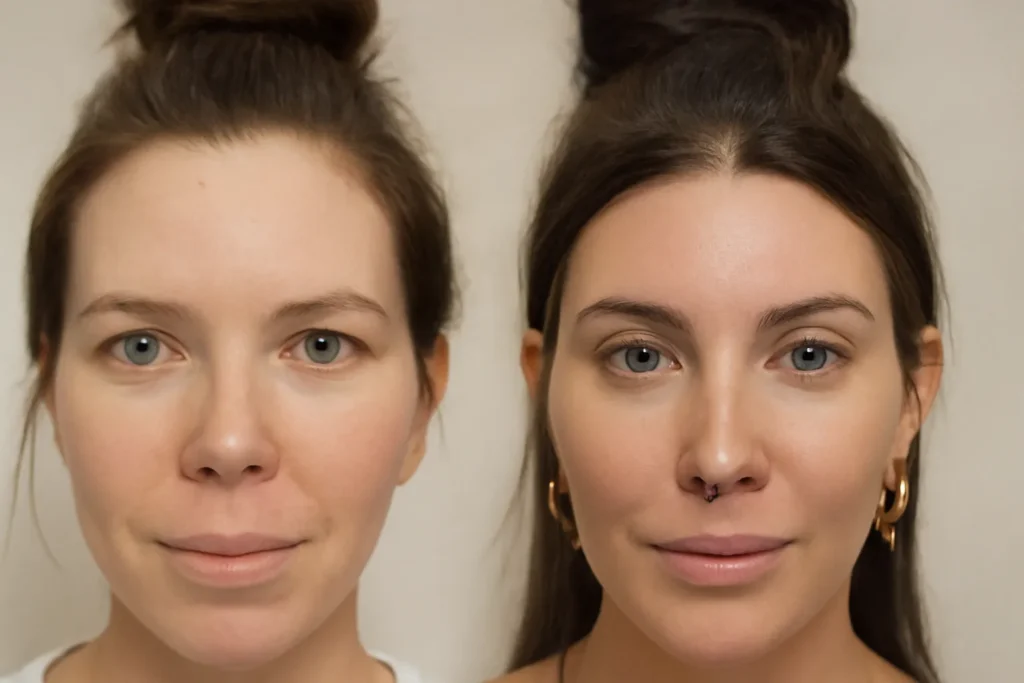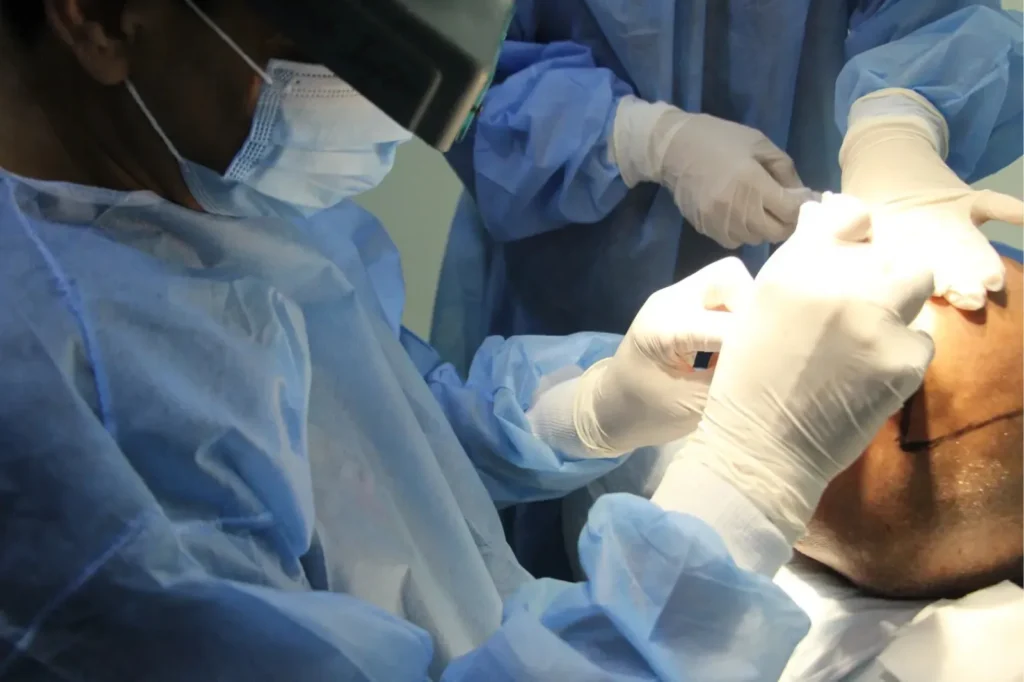Are you bothered by a high hairline that throws off your facial balance? Hairline lowering surgery in Denver can effectively reposition a high forehead, restoring harmony, confidence, and hairstyle freedom.
In this guide, you’ll learn what the procedure entails, how to prepare and recover, and how to choose a certified Denver surgeon. With real patient stories, expert insights, and a clear recovery timeline, this post empowers you to make a confident decision backed by trusted local expertise. Let’s reshape your look — naturally and safely.
What Is Hairline Lowering (Forehead Reduction)?

Hairline lowering surgery, also known as forehead reduction or scalp advancement, is a cosmetic procedure that reduces the height of the forehead by bringing the hairline forward.
Surgical Definition and Purpose
This outpatient surgery involves removing a strip of forehead skin near the hairline and advancing the scalp forward. It helps improve facial proportions, especially for those with:
- Naturally high hairlines
- Congenital large foreheads
- Hairline recession not suitable for transplant
Common Techniques Used
- Trichophytic incision: Allows hair to grow through the scar for better concealment
- Scalp advancement: Moves the scalp forward for natural results
- May be combined with a brow lift for enhanced outcomes
Ideal Candidates
You may be a good candidate if you:
- Have a naturally high hairline and good scalp laxity
- Are in overall good health
- Are not prone to hypertrophic or keloid scarring
- Have dense frontal hair to help conceal the incision
Why Choose Hairline Lowering Surgery in Denver?
Denver is home to some of the nation’s top board-certified facial plastic surgeons, offering personalized care and advanced techniques in a medically regulated environment.
Denver-Based Expert Credentials
Reputable surgeons in Denver are often:
- Certified by the American Board of Facial Plastic and Reconstructive Surgery
- Members of the International Society of Hair Restoration Surgery (ISHRS)
- Experienced in both male and female forehead reduction cases
State-of-the-Art Techniques
Clinics in Denver offer:
- Customized 3D simulations of expected results
- IV sedation or local anesthesia for comfort
- Minimally invasive techniques to minimize scarring
Step-by-Step Procedure Overview
Initial Consultation
Your journey begins with a personalized consultation. The surgeon will:
- Measure your forehead and assess hairline position
- Evaluate scalp laxity
- Discuss expectations, risks, and surgical options
Pre-Op Preparation Checklist
- Stop blood thinners and smoking 2 weeks before
- Wash hair with antiseptic shampoo the night before
- Arrange transportation and post-op care
In-Surgery Breakdown
- Time: 1 to 2 hours
- A trichophytic incision is made along the hairline
- A strip of forehead skin is removed
- Scalp is advanced and secured with sutures or staples
Recovery Phase Overview
- Light compression dressing applied for 24–48 hours
- Sutures removed in 5–7 days
- Return to normal activities in 1–2 weeks
Recovery Timeline & Precautions
Week 1: Initial Healing
- Swelling, bruising, and mild discomfort are common
- Take prescribed antibiotics and pain medication
- Avoid bending, heavy lifting, and sweating
Weeks 2–4: Gradual Recovery
- Resume desk work
- Refrain from strenuous activity and wearing hats
- Incision may appear pink but will gradually fade
Week 5 and Beyond
- Hair begins to grow through the scar
- Numbness and tightness improve
- Exercise and sun exposure may resume with surgeon’s clearance
What to Avoid During Recovery
- Excessive sweating
- Hair dye or harsh scalp treatments
- Direct sun on incision area
Benefits, Risks & Long-Term Outcomes
Key Benefits
- Creates a more proportional facial appearance
- Immediate and permanent hairline advancement
- Enhances self-confidence
Potential Risks and Side Effects
- Visible scarring (though often minimal)
- Temporary numbness or tingling
- Shock hair loss (usually temporary)
- Infection or poor wound healing (rare with proper care)
Comparison with Hair Transplant
| Feature | Hairline Lowering | Hair Transplant |
|---|---|---|
| Speed | Immediate result | Months for full growth |
| Hair Density | Depends on natural density | Can be customized |
| Scarring | Single linear scar | Multiple dot scars |
| Ideal For | High forehead with lax scalp | Receding hairline |
Choosing the Right Denver Surgeon
What to Look For
- Board certification in facial plastic or cosmetic surgery
- Experience with at least 50–100 forehead reduction cases
- High-resolution before-and-after galleries
Patient Testimonials and Case Studies
Look for clinics that provide:
- Written or video testimonials
- Clear, progressive recovery images
- Long-term follow-up reviews
Questions to Ask During Consultation
- How much will my hairline be lowered?
- What’s your revision rate?
- How do you conceal the scar?
- Do you offer combined procedures like brow lift or transplant?

FAQs
What is the cost of hairline-lowering surgery in Denver?
The average cost ranges from $7,500 to $14,000, depending on the surgeon’s experience, anesthesia type, and complexity.
How much can my hairline be lowered?
Typically, 1.5 to 3 cm (0.5–1.2 inches) is achievable, depending on scalp flexibility.
Will the scar be visible?
Most scars are hidden along the hairline and fade over time. Techniques like the trichophytic incision allow hair to grow through the scar.
When can I resume exercise?
Light activity is okay after 2 weeks. High-impact workouts should be postponed until at least 4–6 weeks post-op.
Can I combine this with other procedures?
Yes. Many patients opt to combine it with brow lift or hair transplant for enhanced results.
Ready for a Natural Hairline in Denver?
If you’re considering hairline lowering surgery in Denver, don’t wait to reclaim your confidence. Book a consultation with a board-certified facial plastic surgeon and find out if you’re a candidate. With trusted local expertise and proven results, your transformation starts today.
